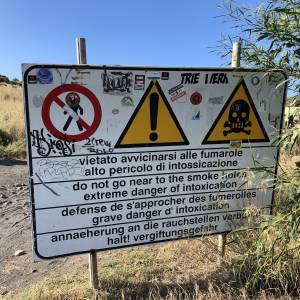
Les îles Éoliennes - Une zone de navigation secrète.
Nous avons navigué le long de la côte est de la Sardaigne et passons devant la Costa Smeralda, le terrain de jeu des riches et des puissants. La taille est importante ici car chaque super yacht que nous avons vu a grandi en taille et en opulence. Ce qui est bien, c’est qu’une fois cette zone passée, il y a beaucoup d’ancrages libres et bien protégés pour ceux qui ne peuvent pas s’engager dans le jeu «La mine est plus grande et meilleure que la vôtre»!
À l'extrémité sud de la Sardaigne, au nord-est de Cagliari, se trouve le port de plaisance de Villasimius. C'est un endroit idéal pour un changement d'équipage avant de se diriger vers l'est. Au lieu de nous diriger vers la Sicile, nous avions décidé de voir un volcan actif. Les Eoliennes sont un chapelet d'îles volcaniques situées au nord-est de la Sicile. Stromboli se situe à l'extrémité nord de la chaîne et fascine les marins depuis des milliers d'années. Les Anciens l'utilisaient comme point de passage sur le chemin de Messine. Nous sommes partis dans des airs très légers sur ce qui allait être un passage de 48 heures. Le vent léger était très frustrant et il a semblé que cela a pris des siècles pour que la Sardaigne disparaisse au-dessous de l'horizon. À 23h00 cette nuit-là une brise fraîche est venue du sud. Nous étions bientôt en train de galoper à 8,5 nœuds dans une portée de faisceau parfaite sous le principal et le génois. Citadel a parcouru les kilomètres dans ces conditions idéales. Une brise assez forte pour faire avancer Citadel rapidement mais presque sous un vent qui commence à projeter des embruns sur le bateau. Cette nuit-là, nous avons dormi à tour de rôle sur les confortables coussins du poste de pilotage. Il n'y a pas eu de réveil grossier si ce n'est qu'on m'a dit que c'était à nouveau à mon tour d'être de garde. Je me suis endormi épuisé mais hypnotisé par le ciel étoilé dans le ciel noir. Cet environnement n’est possible que maintenant en mer, loin des lumières artificielles.
À l'approche de l'aube, le vent s'est arrêté et nous avons été obligés de conduire pendant quelques heures. Cela nous a donné une chance de recharger nos batteries, donc ce n'était pas tout à fait négatif. Au début de l'après-midi, l'île d'Ustica est apparue sur notre arc de tribord et y est restée presque jusqu'au coucher du soleil alors que nous naviguions vers le nord. Ustica a une longue et sombre histoire d’île prisonnière. Il est à peine plus de la moitié de la distance qui sépare l’archipel des îles Éoliennes. Il y avait trois membres d'équipage à bord, mais seulement deux partageaient les montres. La douceur des conditions rendait les montres confortables alors que nous continuions à dormir dans le cockpit ouvert.
Le lendemain, vers midi, Alicudi, la plus à l'ouest des îles, apparut et pendant l'après-midi, nous filâmes devant Filicudi et Lipari pour jeter l'ancre à l'ancre ouest d'Isola de Vulcano. Nous ne sommes pas allés à terre ce soir-là, nous avons rangé le bateau et nous nous sommes préparés à des «opérations amphibies» le matin. Nous avions décidé de grimper au bord du cratère à Vulcano. L’île n’est en réalité qu’un seul grand volcan qui crache encore du sulfure d’hydrogène nocif.
La première heure de la matinée avant qu'il ne fasse trop chaud et, alors que les pentes occidentales du cratère étaient encore à l'ombre, nous avons lancé l'appel d'offres et nous nous sommes dirigés vers le rivage. Une fois l'appel d'offres sécurisé, nous avons revêtu nos chaussures de marche et avons poursuivi notre route jusqu'au bord. Tous les quelques centaines de mètres, des panneaux nous avertissaient des dangers des gaz émanant des fumerolles. On ne monte pas dans le cratère d'un volcan plus de deux fois dans une vie, donc on ne nous a pas découragés. Au sommet, en plus des émissions de fumée, nous avons été récompensés par des vues spectaculaires sur toutes les îles situées au nord et à l'ouest. Stromboli était clairement visible. Ce devait être notre prochaine destination. Il était bientôt temps de descendre pour goûter à la plage chaude et froide de la mer et, plus important encore, pour goûter au granit (un adorable chou italien) et à leurs gélatos. J'ai réalisé que je développais une dépendance dangereuse aux produits de leurs belles «gelaterias»! La prochaine fois, je vous raconterai comment nous avons dérivé au large pour observer les éruptions de Stromboli. Aucune de ces îles n’a d’aéroport. Vous pouvez seulement visiter en bateau. Trouvez celui qui vous convient sur www.boatshedgibraltar.com.



